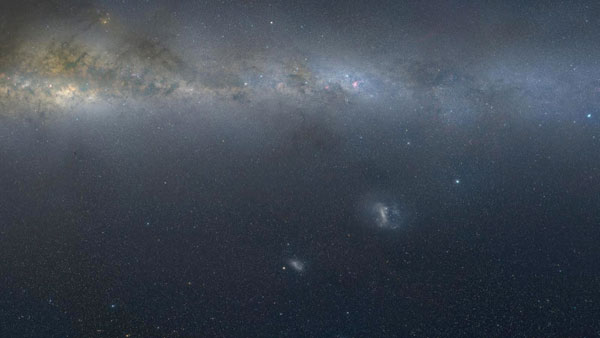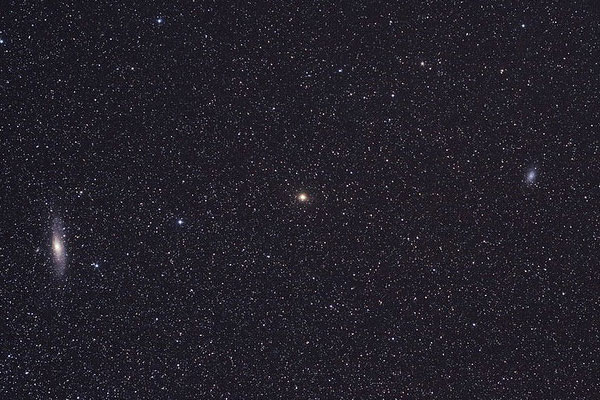A combination of simulations and observations indicates that galaxies like the Large Magellanic Cloud control when punier dwarfs plunge into large galaxies.
When midsize galaxies merge with large ones, they drag a lot of little galaxies with them, Eric Bell (University of Michigan, Ann Arbor) reported June 9th at the virtual summer meeting of the American Astronomical Society.

Axel Mellinger, Central Michigan Univ.
To investigate the dwarf galaxy population of the Local Group in which the Milky Way and Andromeda galaxies live, Bell and Richard D’Souza (Vatican Observatory, Italy) simulated the clouds of dark matter in which Milky Way–mass galaxies reside. By following the interactions of 48 of these simulated haloes with smaller surrounding ones (stand-ins for dwarf galaxies), the astronomers discovered something interesting: Satellites tended to merge in groups with the big galaxy, with smaller galaxies tagging along when a midsize one merged with the central leviathan. The effect didn’t increase the number of infalling galaxies; it only changed when they fell in.
To test these predictions, the team looked at when star formation shut off in real-life, smaller galaxies surrounding the Milky Way and Andromeda. Starbirth, the astronomers reasoned, is a good proxy for merger time, because the little galaxies would likely be stripped of their star-forming gas when they fell into the big, hot halo of the central galaxy. And indeed, observations show that star formation shut off in the Milky Way satellites around two periods of time when a sizable galaxy was falling in — about 2 billion years ago for the Large Magellanic Cloud and 10 billion years ago for Gaia-Enceladus.

JP Stanley
Conversely, there’s only one turn-off time for Andromeda satellites: about 6 billion years ago. That suggests that Andromeda’s largest companion, M33, might have started its nosedive into Andromeda’s halo around then. The timeline would problematize others’ suggestion that M33 is on its first flyby past Andromeda and, like the LMC, had only arrived in the last couple billion years. A closer look at Andromeda’s satellite family could elucidate just when M33 showed up for its visit.
Astronomers are now able to explore the satellites of large galaxies out to several tens of millions of light-years from us, and if borne out, these results may enable them to discern such galaxies’ histories more clearly. The team’s work appears in the July Monthly Notices of the Royal Astronomical Society.
 0
0









Comments
You must be logged in to post a comment.